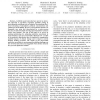Free Online Productivity Tools
i2Speak
i2Symbol
i2OCR
iTex2Img
iWeb2Print
iWeb2Shot
i2Type
iPdf2Split
iPdf2Merge
i2Bopomofo
i2Arabic
i2Style
i2Image
i2PDF
iLatex2Rtf
Sci2ools
IJCNN
2006
IEEE
2006
IEEE
Predictive Uncertainty in Environmental Modelling
Abstract— Artificial neural networks have proved an attractive approach to non-linear regression problems arising in environmental modelling, such as statistical downscaling, shortterm forecasting of atmospheric pollutant concentrations and rainfall run-off modelling. However, environmental datasets are frequently very noisy and characterised by a noise process that may be heteroscedastic (having input dependent variance) and/or non-Gaussian. The aim of this paper is to review an existing methodology for estimating predictive uncertainty in such situations, and more importantly illustrate how a model of the predictive distribution may be exploited in assessing the possible impacts of climate change and to improve current decision making processes. The results of the WCCI-2006 predictive uncertainty in environmental modelling challenge are also reviewed and some areas suggested where further research may provide significant benefits.
| Added | 11 Jun 2010 |
| Updated | 11 Jun 2010 |
| Type | Conference |
| Year | 2006 |
| Where | IJCNN |
| Authors | Gavin C. Cawley, Malcolm R. Haylock, Stephen R. Dorling |
Comments (0)

